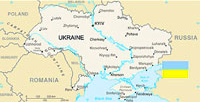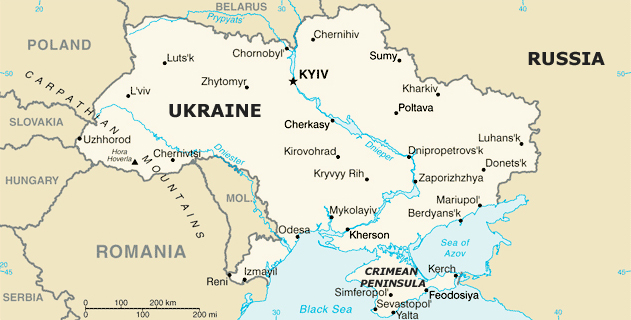War Severs Ukraine’s Industrial Arteries as Economy Sinks

(Bloomberg – bloomberg.com – Agnes Lovasz, Daryna Krasnolutska – October 2, 2014) The bloody conflict in Ukraine’s east is severing the arteries that connect the nation’s economy.
The effects are being felt hundreds of miles from the unrest in industries as different as electricity and food processing. Power plants at the other end of the country are being starved of coal because of disruptions to mining, while in Kiev, one of Ukraine’s biggest poultry producers is looking abroad for incubatory eggs after output was halted at its facility near the war-ravaged city of Donetsk.
Months of fighting have left pro-Russian rebels in control of a swathe of Ukraine’s easternmost regions, which generated almost a quarter ofindustrial output at the start of the year. The knock-on effects of idle factories are seeping through an economy at risk of a 10 percent contraction in 2014, according to Ukraine’s central bank. The International Monetary Fund says $17 billion may not be enough to avert a default.
“Everything is interlinked and companies in the rest of Ukraine will suffer,” Liza Ermolenko, an analyst at London-based Capital Economics Ltd., said by e-mail. “That’s on top of the indirect channels through which the conflict in the east affects the rest of the economy — the currency, banks, inflation and confidence channels.”
Power Cutoffs
The Donetsk and Luhansk regions that border Russia are home to the bulk of Ukraine’s steel mills and coal mines. August industrial productionplunged 85 percent in Luhansk and 59 percent in Donetsk from a year earlier, resulting in a nationwide contraction of a fifth, the most since 2009, according to Ukraine’s statistics office.
Standoff in Ukraine
DTEK B.V., Ukraine’s largest private energy company, needs a type of coal that’s only mined in Luhansk to fuel about half of its power stations, according to Chief Executive Officer Maxim Timchenko. Without that, or alternative supplies from Russia, there’s a risk to household electricity flows, he said.
“The mines are located in the southern part of Luhansk,” which is out of the government’s control, Timchenko said in a Sept. 18 interview. “The main problem is how to get it out of that area and ship it to our power plants.”
While a cease-fire signed by President Petro Poroshenko is holding in the two regions, known as Donbas, billionaire Rinat Akhmetov’s DTEK cut electricity to industrial customers in the capital, Kiev, last week. About a third of Donbas, whose total population is 6.5 million, has been handed over to separatist control for three years after lawmakers granted rebel-held areas special status last month.
‘Significant Deterioration’
Production costs at London-listed poultry company MHP SA (MHPC) have risen as much as 8 percent since its egg farm closed, prompting it to seek some imports from Germany and Hungary, Anastasia Sobotyuk, an investor relations officer, said Sept. 19 by phone. Shelling has prevented the company from visiting to assess the damage, which risks a permanent shutdown, she said.
“It won’t be so easy to restart production in many of the facilities that have been damaged,” Erik Berglof, the European Bank for Reconstruction and Development’s chief economist, said Sept. 17. The economy faces “a significant deterioration, reflecting both the immediate decline of production in Donbas but also the broader impact on the economy.”
The ripple effect of the business shutdown in the east presents another challenge to a government facing a laundry list of economic woes as a result of the war. The fighting has helped shut off trade with and energy flows from Russia, exacerbating what’s already the worst recession since a 2009 meltdown. It’s also sent investors fleeing from Ukrainian assets, stoking borrowing costs for the nation of 43 million.
‘Really Drastic’
Ukraine, whose gross domestic product was originally forecast by the IMF to shrink 5 percent this year, has seen a “really drastic deterioration of economic conditions,” central bank Governor Valeriya Gontareva said Sept. 13. An extension of the armed conflict through end-2015 could leave a $19 billion hole in Ukraine’s finances, the fund said Sept. 2.
The recovery won’t be quick, according to the World Bank.
“Disruption to economic ties and infrastructure damage means we don’t expect a fast economic rebound,” World Bank economist Anastasiya Golovach told reporters today in Kiev. “At least in the first half of 2015 GDP growth will continue to be minus.”
Hryvnia Plunge
The central bank’s currency reserves have tumbled toward a nine-year low as the hryvnia plunged 36 percent this year, the most in the world according to data compiled by Bloomberg. The yield on the government’s $2.6 billion of bonds due 2017 has jumped 4.91 percentage points in 2014, with 2.9 percentage points of that coming since the truce was signed.
Ukraine has more than $15 billion of principal and interest payments coming due through end-2015, according to data compiled by Bloomberg.
International funds will continue to prop up the economy, even as the conflict harms the government’s ability to meet the IMF’s fiscal targets, according to Otilia Dhand, an analyst at Teneo Intelligence in London.
“If Ukraine falls behind on the program, the conditionality will just be relaxed and they’ll be given a second chance,” Dhand said Aug. 22 by phone. “The only thing the U.S. and the EU are willing and able to do for Ukraine is literally to throw money at it. They aren’t going to get involved militarily in the conflict and they’ll be overcompensating by helping Ukraine financially.”
Restructuring Specter
International aid may come in unison with a government debt restructuring, according to David Spegel, head of EM sovereign & corporate strategy research at BNP Paribas. Restructuring is a matter of when, not if, and investors are pricing in a two-thirds chance they’ll lose 50 percent-55 percent of the value of their holdings, Spegel said in a Sept. 17 report.
Ukraine isn’t considering restructuring “at all,” Halyna Pakhachuk, head of Finance Ministry’s debt department, said Sept. 24 by e-mail.
The durability of the cease-fire may be key to meeting that pledge. In a sign of its fragility, the Ukrainian military said Sept. 29 that nine servicemen had died in the last day, while the army killed 50 militants. The conflict has cost more than 3,500 lives, according to the United Nations.
Without a stable backdrop the supply chains that link east and west can’t be reconnected. An end to hostilities is needed to get Ukraine’s economy back on track, according to Simon Quijano-Evans, the London-based head of emerging-market research at Commerzbank AG.
“Peace is the most crucial thing,” he said Sept. 18 by e-mail. “Without that, any detrimental economic, financing scenario can be envisaged.”
Article ©2014 Bloomberg L.P. All Rights Reserved Article also appeared at bloomberg.com/news/2014-10-01/war-severs-ukraine-s-industrial-arteries-as-economy-sinks.html

